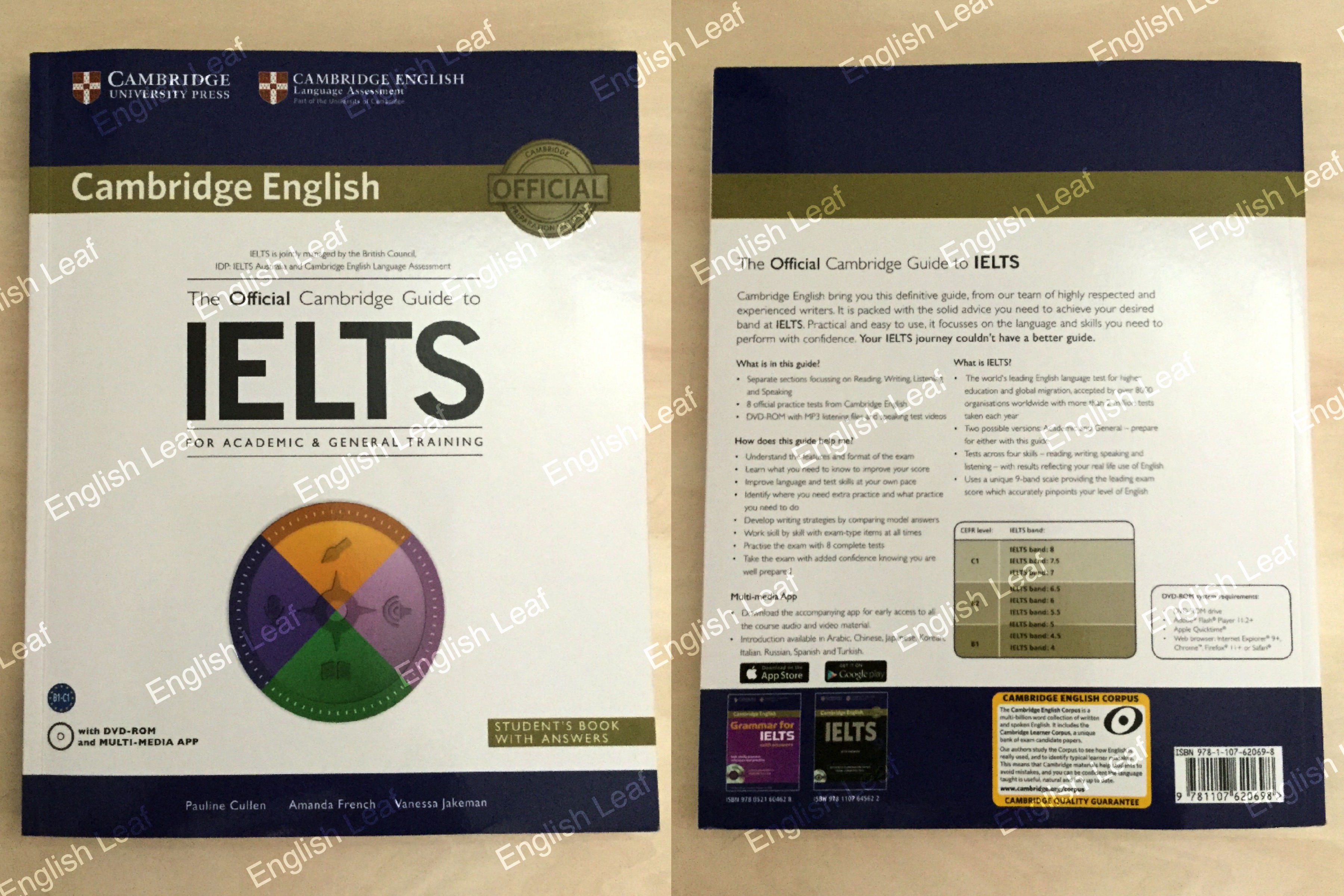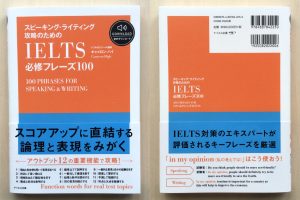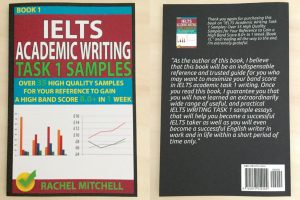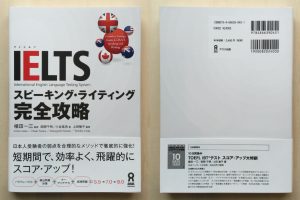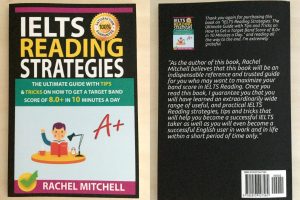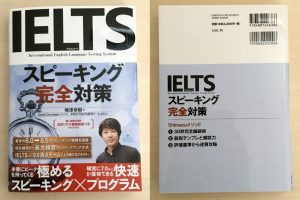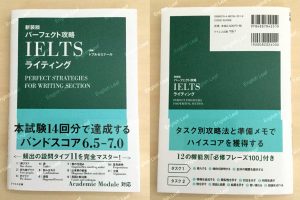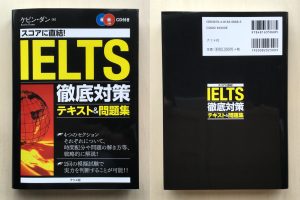IELTSオフィシャルガイドテキスト
公式がだしているオフィシャルのテキストとなります。テストの各セクションの説明があり、8回のテストも含まれています。こちらも一度確認することにより、さまざまな種類の演習が行われるテストの各部分(リーディング、ライティング、リスニング、スピーキング)のセクションと、それらを最良の方法で実行するための多くのヒントを備えた方法で構成されています。是非、直近のケンブリッジ出版社から出ている模試以外にも確認しておきましょう。

Contents
Introduction
IELTS Summary
IELTS Listening skills
1 Getting ready to listen
1 Understanding the context
2 Using the correct spelling
3 Writing numbers
2 Following a conversation
1 Identifying the speakers
2 Identifying function
3 Understanding categories
3 Recognising paraphrase
1 Identifying distractors
2 Recognising paraphrase
3 Selecting from a list
4 Places and directions
1 Describing a place
2 Following directions
3 Labelling a map
5 Listening for actions and processes
1 Understanding mechanical parts
2 Describing an action or process
3 Describing a process
6 Attitude and opinion
1 Identifying attitudes and opinions
2 Persuading and suggesting
3 Reaching a decision
7 Following a lecture or talk
1 Identifying main ideas
2 Understanding how ideas are connected
3 Understanding an explanation
8 Contrasting ideas
1 Signposting words
2 Comparing and contrasting ideas
3 Using notes to follow a talk
IELTS Reading skills
1 Reading strategies
1 Using the features of a Reading passage
2 Skimming a passage and speed reading
3 Global understanding
2 Descriptive passages
1 Scanning for detail
2 Using words from the passage
3 Notes/flow-chart/diagram completion
3 Understanding the main ideas
1 Identifying the main idea
2 Understanding the main points
3 Identifying information in a passage
4 Locating and matching information
1 Identifying types of information
2 Locating and matching information
3 How ideas are connected
5 Discursive passages
1 Discursive passages
2 Identifying theories and opinions
3 Matching features
6 Multiple-choice questions
1 Understanding longer pieces of text
2 Different types of multiple choice
3 Identifying a writer’s purpose
7 Opinions and attitudes
1 Argumentative texts
2 Identifying the writer’s views/claims
3 Identifying grammatical features
8 General Training Reading
1 The General Training Reading paper
2 Dealing with multiple texts
3 Understanding work-related texts
IELTS Writing
1 Academic Writing Task 1 – Describing a chart, table or graph
1 Understanding graphs, tables and charts
2 More complex charts
3 Improving your Task Achievement score
2 Academic Writing Task 1 – Comparing and contrasting graphs and tables
1 Avoiding repetition
2 Comparing and contrasting data
3 Grammatical Accuracy – describing numbers and figures accurately
3 Academic Writing Task 1 – Describing diagrams
1 Understanding a diagram
2 Describing a process – coherence and cohesion
3 Lexical Resource – being accurate
4 Academic Writing Task 1 – Describing maps
1 Describing a map
2 Describing changes in a place
3 Grammatical Accuracy
5 General Training Writing Task 1 – A letter
1 Understanding the task
2 Improving your score
3 Checking and correcting
6 Writing Task 2 – Getting ready to write
1 Understanding the task
2 Planning and organising your ideas
3 Getting started – writing an introduction
7 Writing Task 2 – Expressing your ideas clearly
1 Linking ideas – cohesion
2 Lexical Resource – avoiding repetition
3 Expressing a personal view
8 Writing Task 2 – Checking and correcting
1 Developing your ideas clearly
2 Grammatical Accuracy
3 Assessing your language
IELTS Speaking
1 The Speaking Test – Part 1
1 Getting ready to speak
2 Part 1 – talking about familiar topics
3 Using the right tense – Grammatical Range and Accuracy
2 Part 2 – Giving a talk
1 Understanding the task
2 Improving Fluency and Coherence
3 Organising your notes and your talk
3 Part 3 – Talking about abstract topics
1 Talking about abstract topics
2 Agreeing and disagreeing
3 Improving your Lexical Resource score
4 Checking, correcting and assessing
1 Dealing with problems
2 Pronunciation, intonation and ‘chunking’
3 Assessing yourself and improving your score
Practice Tests
Practice Test 1
Practice Test 2
Practice Test 3
Practice Test 4
Practice Test 5
Practice Test 6
Practice Test 7
General Training Test
Practice Test 8
General Training Test
Recording Scripts
Answer Key
Sample Answer Sheets
Introduction
Who is this book aimed at?
This book is designed for candidates of any level hoping to take the IELTS test. It is suitable for students working alone or in a classroom situation. The materials can be used for self-study, or can be integrated into an IELTS preparation course. The book is also a valuable resource for teachers who are preparing IELTS candidates.
How can students of different levels use this book?
The IELTS test has two modules: the Academic Module and the General Training Module (see the following pages for an explanation of the two). Each Academic Module candidate will take the same test, no matter what his or her English level is. Similarly, each General Training candidate will take the same General Training test. So, the information in this book is useful and important to students of every level.
Lower-level language students generally need more guided practice and there are exercises in this book to provide this. However, they also need experience and practice in expressing themselves more freely, as this is what IELTS requires them to do. Similarly, more advanced students need 1 frequent opportunities for self-expression, but they also need to become more self-critical and aware of their own common mistakes. Corpus research has shown that even high-level candidates make careless slips, so all levels can benefit from both controlled and free practice.
What are the aims of this book?
This book aims to provide an official, comprehensive guide to IELTS as well as a range of authentic practice tests. The skills section of the book provides
- a detailed explanation of each paper and each section of IELTS;
- examples of the different types of question candidates can expect to find in each section;
- an analysis of the language skills and strategies needed for each type of question;
- study tips and test tips that can help you to achieve your best score.
This book also contains eight complete Practice Tests, to give you thorough preparation.
How is the book organised?
At the beginning of the book, there is a summary of each IELTS paper. Then, there are four sections dealing with the four skills covered in IELTS: Listening, Reading, Writing and Speaking. These are divided into units, which focus on key areas aiming to build your abilities and confidence, and provide authentic test practice. The second half of the book contains eight complete Practice Tests, each with a comprehensive answer key. The first practice test contains hints and reminders to guide you. At the end of the book, you will find the Answer Key and complete Recording Scripts.
How do I use this book?
For the skills sections, it is best to work through each unit in order. This is because the tasks and information are graded, developing your skills as the units progress. However, the different skills can be covered in any order. For example, you may decide to concentrate on only one skill at a time, or you may want to work on all four skills to provide a more balanced course. You should study all of the skills units before taking the Practice Tests. When taking the Practice Tests, try to use the tips and strategies recommended in the skills units. You should also try to take the tests under exam conditions and stick closely to the time limits in the test.
How is this book different from other books?
The skills units and Practice Tests have been written by IELTS exam writers, so you can be sure they contain authentic, accurate and up-to-date information and advice. For the first time, we have also included a DVD showing IELTS Speaking tests, along with a commentary to explain the candidates’ scores. Our writers have used the Cambridge Learner Corpus to help choose the most appropriate language and skill areas to focus on.
What is the Cambridge Learner Corpus?
The Cambridge Learner Corpus is the world’s largest learner corpus. It is made up of thousands of exam scripts written by students from all over the world who have taken Cambridge English exams. The corpus allows us to see the types of error candidates commonly make in the IELTS exam at each different level.
What is ‘paraphrase’ and why is it important?
Paraphrase is the use of different words to express the same idea. In order to test whether you have understood the Reading and Listening texts, the questions in IELTS will paraphrase the words used in the texts. In the Writing and Speaking sections of the test, being able to use paraphrase, instead of simply repeating and copying the words in the question, will show that you have a wide vocabulary and help you to achieve a higher score. So. using and understanding paraphrase is important in every part of the test
IELTS Summary
IELTS Academic Module
The IELTS Academic Module can be used for undergraduate or postgraduate study or for professional reasons.
Academic Reading
Time: one hour
N.B. This includes the time needed to transfer your answers to an answer sheet. There is no extra time for this.
The Reading paper consists of three different texts and a total of 40 questions.
The texts are authentic and academic in nature, but written for a non-specialist audience. They are similar to the types of texts you may find in newspapers or magazines. The style may be descriptive or argumentative and at least one text contains detailed logical argument. Texts may contain illustrations. If a text contains technical terms, a simple glossary is provided. The three texts are graded from easiest to most difficult. Each text will have 12-14 items.
Overview of task types
| Task type | What do I have to do? |
| 1 multiple choice | ・Choose one answer from alternatives A-D. ・Choose two answers from alternatives A-E. ・Choose three answers from alternatives A-G. |
| 2 identifying information (T/F/NG) | Say whether a statement is True, False or Not Given. |
| 3 identifying the writer’s views/ claims (Y/N/NG) |
Say whether a statement agrees with claims or views (Yes), disagrees with the views/claims (No) or whether there is no information on this (Not Given). |
| 4 matching information | Match information to a paragraph in the text. |
| 5 matching headings | Match a heading from a list of possible answers to the correct paragraph or section of the text. |
| 6 matching features | Match a list of statements to a list of possible answers in a box (e.g. specific people or theories or dates). |
| 7 matching sentence endings | Complete a sentence by choosing a suitable ending from a box of possible answers. |
| 8 sentence completion | Complete a sentence with a suitable word or words from the text within the word limit given. |
| 9 notes/summary/table/flow chart completion |
Complete notes/a summary/a table/flow-chart with a suitable word (or words) from a text. |
| 10 labelling a diagram | Label a diagram with a suitable word (or words) from the text or from a box of possible answers. |
| 11 short-answer questions | Answer questions using words from the text. |
Assessment: each question is worth one mark.
Academic Writing
Time: one hour
This test consists of two separate writing tasks. You must answer both tasks.
| Task | Timing | Length | What do I need to do? |
| Writing Task 1 |
20 minutes | 150 words | You need to accurately describe and summarise visual information. The information may be presented in a diagram, map, graph or table. |
| Writing Task 2 |
40 minutes | 250 words | You need to write a discursive essay. You will be given an opinion, problem or issue that you need to respond to. You may be asked to provide a solution, evaluate a problem, compare and contrast different ideas, or challenge an idea. |
You will be assessed on the following criteria:
- Task Achievement
- Coherence and Cohesion
- Lexical Resource
- Grammatical Range and Accuracy
Writing Task 2 is worth twice as much as Writing Task 1.
Listening
Time: approximately 30 minutes (plus an additional 10 minutes to transfer your answers) Academic and General Training candidates take the same Listening test. This consists of four separate sections and a total of 40 questions. Sections 1 and 2 are set in a social context and Sections 3 and 4 are set in an academic context. In the IELTS Listening, you will hear the text
ONCE ONLY. Each test is divided up as follows.
| Section | What kind of text will I hear? |
| 1 | A conversation between two people about a general topic with a transactional purpose (e.g. finding out information about travel). |
| 2 | A monologue or prompted monologue on a general topic with a transactional purpose (e.g. giving information about events in the community). |
| 3 | A conversation between two or three people in an academic context (e.g. a student and a tutor discussing an academic problem). |
| 4 | A monologue in an academic context (e.g. a lecture). |
There are ten questions for each section in the listening test. Below are the task types that you may find in any section. You may have between one and three different tasks per section.
| Task type | What do I have to do? |
| notes/summary/table/flowchart completion | Complete notes/a summary/table/flow-chart with a suitable word or words within the word limit given. |
| multiple choice | Choose one answer from alternatives A-C. Choose two answers from alternatives A-E. |
| short-answer questions | Answer questions in the word limit given. |
| sentence completion | Complete a sentence with a suitable word or words within the word limit given. |
| labelling a diagram, plan or map | Label a diagram/plan or map with a suitable word (or words) or by choosing from a box of possible answers. |
| classification | Classify the information given in the question according to three different criteria (A, B or C). These may be dates, names, types, etc. |
| matching | Match a list of statements to a list of possible answers in a box (e.g. people, theories or dates). |
Assessment: each question is worth one mark.
Speaking
Time: 11-14 minutes
This test consists of an interview with a trained examiner. The intern is recorded and has three separate parts.
| Part | Timing | What will I need to talk about? |
| 1 | 4-5 minutes |
Questions on familiar topics (e.g. hobbies, likes and dislikes, etc.). |
| 2 | 3-4 minutes |
You will be given a booklet with a topic (e.g. describe a good friend) and some suggestions. You need to talk about the topic for 1-2 minutes. You have about one minute to write notes before you begin. |
| 3 | 4-5 minutes |
The examiner will ask you more detailed and more abstract questions about the topic in Part 2 (e.g. How important is friendship?). |
You will be assessed on the following criteria:
- Fluency and Coherence
- Lexical Resource
- Grammatical Range and Accuracy
- Pronunciation
General Training Module
The General Training Module is commonly used for vocational training programmes (not at degree level) or for immigration purposes.
Candidates for the General Training Module take the same Listening and Speaking test as the Academic Module. Only the Reading and Writing papers are different.
General Training Reading
Time: one hour
N.B. This includes the time needed to transfer your answers to a separate answer sheet. There is no extra time given for this.
This test consists of three different sections and a total of 40 questions
The texts are about more general topics or related to work. The General Training Reading paper has three sections, each of increasing difficulty.
The sections are organised as follows.
| Section | Reading texts |
| 1 | two or three short texts or several shorter ones (e.g. advertisements) |
| 2 | two texts related to the workplace (e.g. information for staff) |
| 3 | one long discursive text |
The General Training Reading paper has a total of 40 questions. Section 1 has 14 items. Sections 2 and 3 each have 13.
| Task type | What do I have to do? |
| 1 multiple choice | ・Choose one answer from alternatives A-D. ・Choose two answers from alternatives A-E. ・Choose three answers from alternatives A-G. |
| 2 identifying information (T/F/NG) |
Say whether a statement is True/False or Not Given in the text. |
| 3 identifying the writer’s views/claims (Y/N/NG) |
Say whether a statement agrees with claims or views in a text (Yes), disagrees with the views/claims in the text (No) or whether there is no information on this in the text (Not Given). |
| 4 matching information | Match the information in the question to the correct paragraph in the text. |
| 5 matching headings | Match a heading from a list of possible answers to the correct paragraph or section of the text. |
| 6 matching features | Match a list of statements to a list of possible answers in a box (e.g. specific people or theories or dates). |
| 7 matching sentence endings |
Complete a sentence by choosing a suitable ending from a box of possible answers. |
| 8 sentence completion | Complete a sentence with a suitable word or words from the text within the word limit given. |
| 9 notes/summary/table/ flow-chart completion |
Complete notes/a summary/table/flow-chart with a suitable word (or words) from the text within the word limit given. |
| 10 labelling a diagram | Label a diagram with a suitable word (or words) from the text or by choosing from a box of possible answers. |
| 11 short-answer questions | Answer questions using words from the text in the word limit given. |
| 12 multiple matching | Match the information in the question to the correct short text or advertisement. |
Assessment: each question is worth one mark.
General Training Writing
Time: one hour
This test consists of two separate writing tasks. You must answer DO tasks.
| Task | Timing | Length | What do I need to do? |
| Writing Task1 |
20 minutes | 150 words | Write a letter in response to a given situation. |
| Writing Task2 |
40 minutes | 250 words | You need to write a discursive essay. You will be given an opinion, problem or issue that you need to discuss. You may be asked to provide a solution, evaluate a problem, compare and contrast different ideas or opinions, or challenge an argument or idea. |
You will be assessed on the following criteria:
- Task Response
- Coherence and Cohesion
- Lexical Resource
- Grammatical Range and Accuracy
N.B. Writing Task 2 is worth twice as many marks as Writing Task 1.

